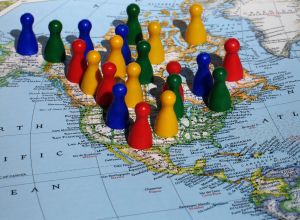 Editor's note: If you score as badly on this fun little quiz as I did, I highly recommend the fantastic book I Used To Know That: Geography by Will Williams. For even more fun, check out the rest of the I Used to Know That series. LMH
Editor's note: If you score as badly on this fun little quiz as I did, I highly recommend the fantastic book I Used To Know That: Geography by Will Williams. For even more fun, check out the rest of the I Used to Know That series. LMH
Geography Quiz
By Will Williams
Author of I Used To Know That: Geography: Stuff You Forgot From School
“Without geography, you’re nowhere.”
- Jimmy Buffett
1. The Tropic of Cancer and the Tropic of Capricorn are two imaginary lines running east and west around the globe. Which one lies north and which south of the equator?
A) Tropic of Cancer - North / Tropic of Capricorn - South
B) Tropic of Cancer - South / Tropic of Capricorn - North
A: The Tropic of Cancer is located at 23.5 degrees north of the equator and is the spot on the planet where the sun is directly overhead at noon on June 21. The Tropic of Capricorn lies at 23.5 degrees south of the equator and is the spot where the sun is directly overhead at noon on December 21.
2. What is the Ring of Fire?
A) A twenty mile circle of radioactive land in Antarctica.
B) A brightly colored stretch of coral barrier reef off the coast of Belize.
C) A large horseshoe shape area marking volcanic areas in the Pacific.
C: The Ring of Fire is an arc of intense seismic and volcanic activity stretching from New Zealand, along the eastern edge of Asia, north across the Aleutian Islands of Alaska, and down the coast of North and South America. More than 75 percent of the world’s volcanoes lie within this ring.
3. True or False. Hawaii is a North American U.S. state?
False: Yes, Hawaii is a U.S. state, but technically is not part of North America. It is grouped with Australia and the other Pacific Islands.
4. What is the largest U.S. state?
A) Texas
B) California
C) Alaska
D) Montana
E) Rhode Island
C: While everything might be bigger in Texas, Alaska (570,00 square miles) is more than twice the size of the Lone Star State.
5. Talking about elevation, what is the highest city in the world?
A) Denver
B) La Rinconada
C) Mount Everest
D) Salt Lake City
E) Lake Louise
B: While Mount Everest holds the title for highest point in the world, La Rinconada in Peru is the highest city in the world with an elevation of 16,728 feet. That’s over three times higher than Denver, the mile-high city!
6. The country of Japan consists of how many islands?
A) 10 - 100
B) 100 - 1,000
C) 1,000 - 10,000
C: Japan, which is an archipelago, consists of more than 3,000 adjacent islands including Okinawa.
7. What is Asia Minor?
A) A group of the smallest countries in Asia.
B) A western peninsula of Asia.
C) A term for Asian regions with high levels of poverty.
D) A low-lying strip of land that stretches across the Asian continent.
B: A bygone term, Asia Minor is most likely referred to as Anatolia: the westernmost protrusion of Asia, which is occupied by Turkey.
8. True or False. The last Ice Age was over 650,000 years ago.
False: Sort of. Mount Tambora erupted in Indonesia in 1815, causing what became known as the Little Ice Age. Volcanic ash in the atmosphere blocked out incoming solar radiation, and global temperatures plummeted. The following year was known as the Year without a Summer with reports of June and July frost and snow in New England and Northern Europe.
9. What is a Fjord?
A) A narrow arm of the sea bordered by steep cliffs.
B) A geographical anomaly resembling a popular automobile.
C) Shallow coastal waters containing a high level of biodiversity.
D) An extraordinary annual event when a river reverses its direction of flow.
A: A fjord is a steep-sided inlet cut into mountains by glaciers, creating spectacular scenery. Norway is famous for its fjords, but fjords also occur in Chile and New Zealand.
10. What is the world’s longest mountain range?
A) Andes
B) Rockies
C) Mid-Ocean Ridge
D) Appalachian
E) Himalayas
C: At 40,000 miles long, the undersea Mid-Ocean Ridge is the Earth’s longest mountain range which is four times longer than the Andes, Rockies, and Himalayas combined.
Copyright © 2011 Will Williams, author of I Used To Know That: Geography: Stuff You Forgot From School
Author Bio - Will Williams, author of I Used to Know That: Geography: Stuff You Forgot From School, was born twenty-five yards from the Marston Brewery in Burton upon Trent. He always knew that places would be important in his life. After a good state school education at King Edward's, Lichfield, he went on to Hertford College, Oxford, where he read Geography. Though secretly harboring a desire to be a stuntman, he is currently entrenched as the Head of Geography at St Paul's School, London. The place he calls home, though, is near the banks of the Garonne in South West France, with his wife Christelle and daughter Fleuve.
About the Author

Guest
We welcome guest contributors who graciously volunteer their writing for our readers. Please support our guest writers by visiting their sites, purchasing their work, and leaving comments to thank them for sharing their gifts here on CatholicMom.com. To inquire about serving as a guest contributor, contact editor@CatholicMom.com.


.png?width=1806&height=731&name=CatholicMom_hcfm_logo1_pos_871c_2728c%20(002).png)
Comments